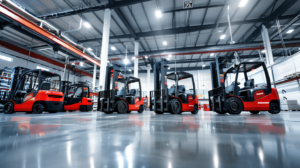In recent years, the push toward sustainability has touched nearly every corner of industry—including one often overlooked: material-handling equipment. Electric forklifts are quietly becoming a key piece in the larger puzzle of greener supply-chains and low-emission logistics. This article explores how Chinese electric forklifts are contributing to a greener future, what drives their adoption, and how companies such as Nicosail play a meaningful role.
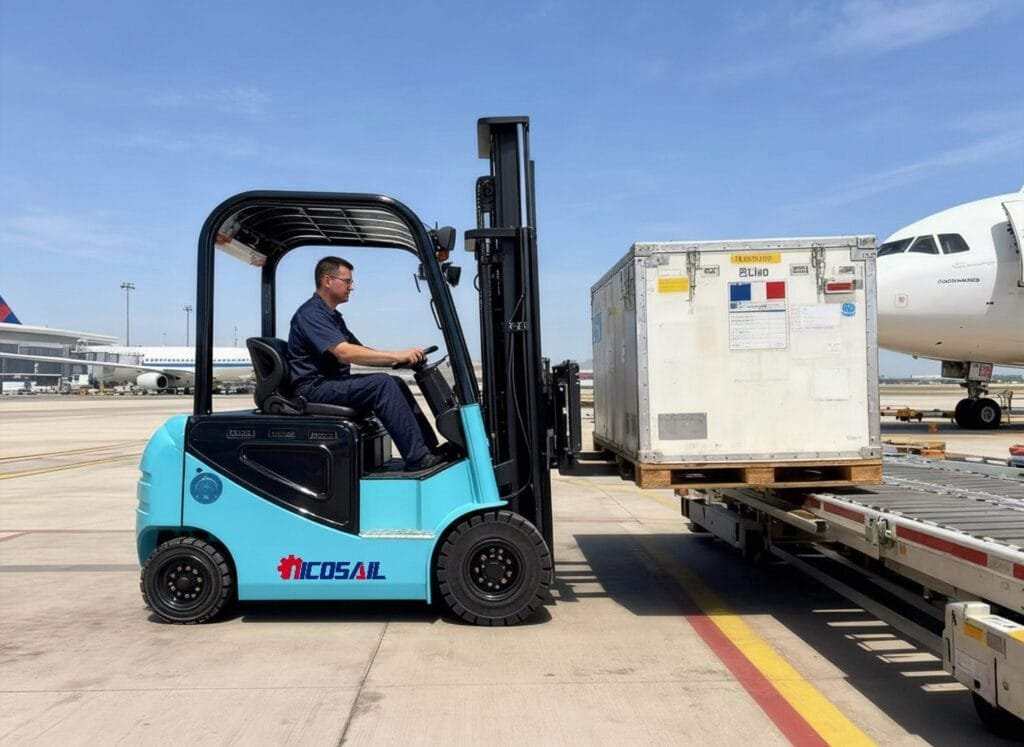
1. The global push for greener material-handling equipment
The global economy is increasingly conscious of its environmental footprint. Warehouses, distribution centres, factories—these hubs of logistics are under pressure to reduce emissions, improve energy efficiency, and adopt cleaner technologies. Material-handling equipment such as forklifts matter in this context because they operate constantly in indoor and outdoor settings, often burning diesel or LPG, generating noise, fumes and heat.
Electric forklifts present a compelling alternative. They produce zero tailpipe emissions at the point of use, reduce noise, and offer lower energy consumption. As e-commerce grows, warehousing density rises, and indoor air-quality standards tighten, the shift to electric forklifts becomes not just desirable but often necessary.
Moreover, the “greener future” goals of many nations (for example carbon-neutral targets, stricter emission standards) mean that industries are under both regulatory and market pressures to modernise. That makes the switch to electric forklifts part of a larger transformation: logistics infrastructure, fleet electrification, green procurement.
In short: The electric forklift is not just a piece of equipment, it’s a symbol of the logistics industry’s transition into a more sustainable era.
2. China’s electric forklift landscape: scale, growth and innovation
China plays a major – and growing – role in the global electric forklift market. According to industry analysis, the Asia-Pacific region dominates the global electric forklift market, with China accounting for about 30.2 % of that market in 2024. The Chinese industry has scaled rapidly, driven by rising manufacturing, logistics, infrastructure builds and domestic demand.
For instance, in 2022, electric forklifts (class I, II, III) in China rose by 2.58 % to 674,782 units, adopting a larger share of the forklift market. Moreover, export growth was strong: China exported 361,541 units in 2022, a 14.50 % increase on the previous year. Historically, China’s forklift industry began decades ago (late 1950s) and has undergone continuous evolution from imitation to innovation.
Recognising this trend, manufacturers have ramped up production capacity and technology development. For example, one source noted that the total production of electric forklifts surpassed 200,000 units in 2023 with major Chinese players among the leaders.
What this means: China is not only a major consumer of electric forklifts, but increasingly a major producer and exporter—contributing to greener logistics worldwide, not just domestically.
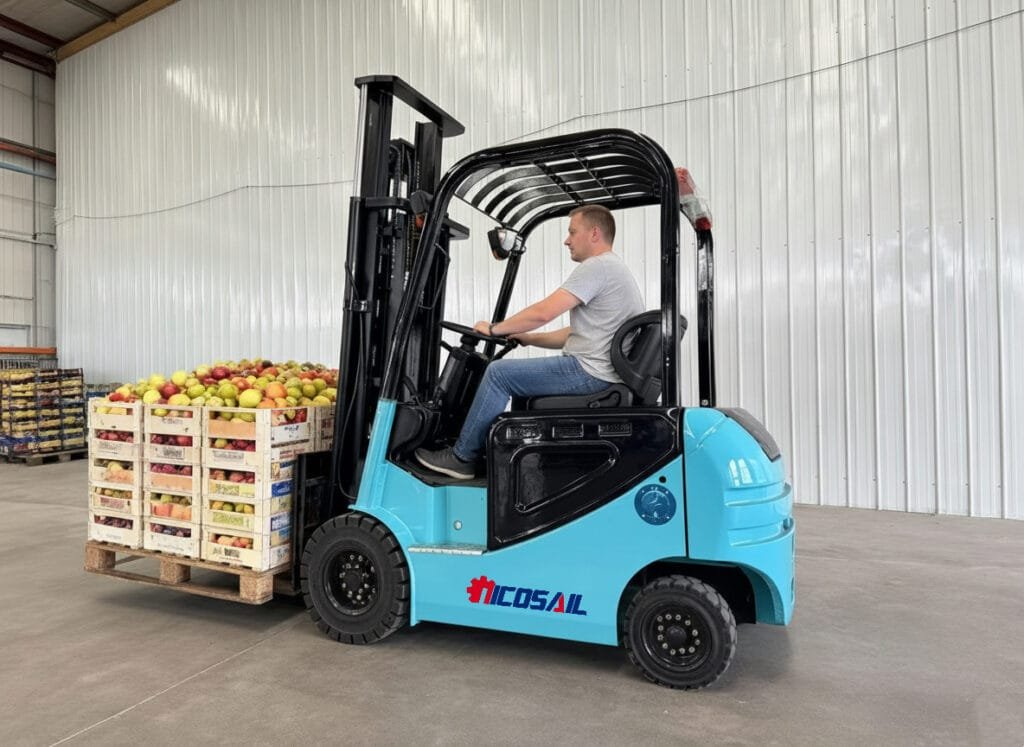
3. Why electric forklifts deliver greener outcomes
Electric forklifts deliver environmental benefits in multiple ways:
3.1 Zero emissions at point of use
The most immediate benefit is that electric forklifts don’t burn diesel or LPG in the warehouse or yard; that means no tailpipe emissions of CO₂, NOₓ, particulate matter or volatile compounds. That contributes directly to cleaner indoor air, safer working environments, and lower local emissions.
3.2 Energy efficiency and battery innovations
Electric drivetrains are typically more efficient than internal-combustion counterparts: less energy wasted in heat, fewer moving parts, and the potential for regenerative braking or energy recovery systems. With improvements in battery technology (for example lithium-ion, LFP types), the runtime, reliability and availability of electric forklifts continue to improve. Battery swapping or fast charging further help.
3.3 Lifecycle advantages vs internal combustion
Beyond the operation phase, electric forklifts may deliver lower total-cost-of-ownership: fewer moving parts, less maintenance, quieter operations, and fewer risks of leaks or chemical emissions. Over the entire lifespan, the environmental footprint can be lower—especially when grids decarbonise and manufacturing becomes greener.
In short: The move to electric forklifts is not just a marginal improvement—it can be a material contribution to greener supply-chains, especially when deployed at scale.
4. Technological advances in Chinese electric forklifts
China’s electric forklift industry is evolving rapidly—bringing in new technologies that enhance both performance and sustainability.
4.1 Battery and power-train improvements
Manufacturers are deploying better batteries (higher energy density, longer life, faster recharge) and efficient motors. This helps electric forklifts match the performance of conventional units while reducing downtime. A strong battery foundation helps reduce greenhouse gas impact when electricity comes from cleaner sources.
4.2 Smart control, telematics and efficiency features
Many modern electric forklifts now include telematics: monitoring of battery health, energy usage, predictive maintenance, route optimisation in warehouses, and integration into warehouse management systems. These features allow fleets to run smarter, reduce energy waste, and extend equipment life.
4.3 Use of renewable energy and circular economy design
Some operations tie forklift fleets to renewable energy sources (solar charging stations, off-peak grid power). Also, manufacturers increasingly consider circular economy aspects: remanufacturing, battery recycling, reuse of modules. These practices enhance the overall “green” credentials of electric forklifts beyond mere operation.
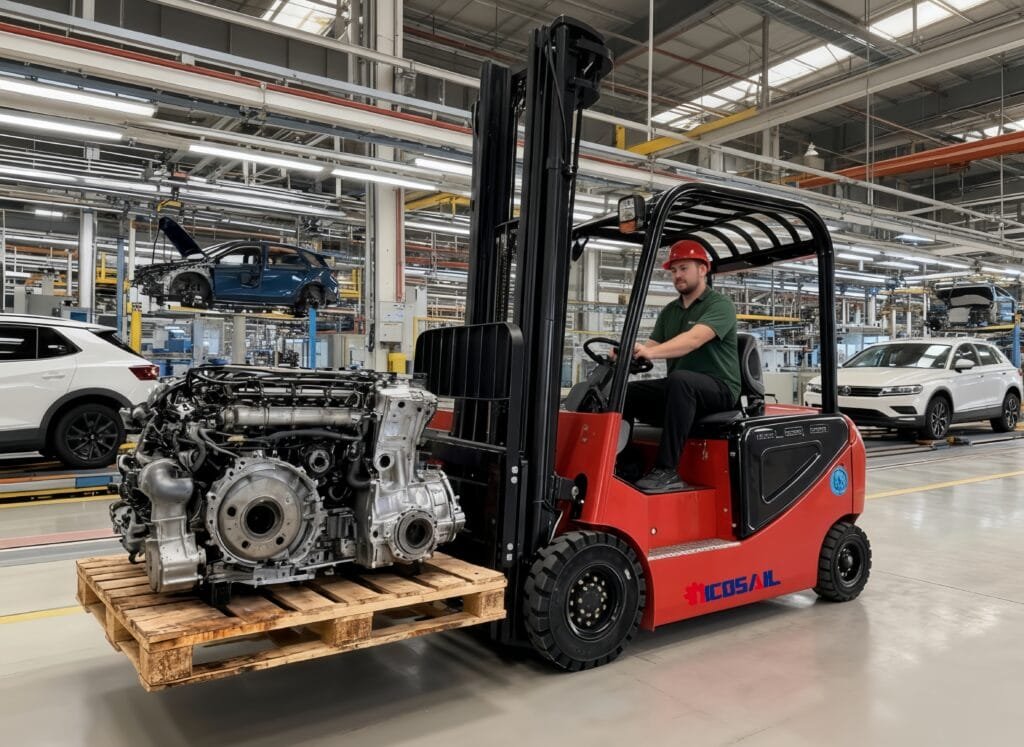
5. Highlight: The role of smaller brands like Nicosail in the green transition
While major global names often get the spotlight, smaller or lesser-known Chinese brands also play an important role in the green transition.
The brand Nicosail (Nicosail) or its formal company “Jining Nicosail Machinery Co., Ltd.” in Shandong province is an example. The company supplies forklifts (including electric models), loaders, excavators and other industrial machinery. On their website, they mention manufacturing forklifts including electric versions: “Electric Forklifts: Eco-friendly and energy-efficient… advanced electric motors and lithium-ion batteries for zero emissions…”.
Here’s how Nicosail’s presence illustrates some of the dynamics of the green transition:
- They are part of the broader ecosystem of Chinese manufacturers expanding capacity and adopting electric designs.
- Their willingness to offer electric-battery counterparts reflects how even mid-sized suppliers are aligning with sustainability trends.
- Because a range of suppliers contributes to competition, innovation, cost reduction and broader accessibility of electric forklifts—benefitting the greener future objective.
Importantly: Mentioning Nicosail here is not an advertisement—it serves to illustrate how diverse and accessible the electric-forklift supply chain in China has become, and how even smaller players are contributing to the shift.
6. Broader environmental and economic impacts
The growth of electric forklifts in China has ripple effects in both environmental and economic domains.
6.1 Reducing carbon footprint across warehousing and logistics
By replacing internal-combustion forklifts, electric models cut direct emissions. As these forklifts multiply in warehouses, ports, manufacturing plants and logistics hubs, the aggregate reduction in greenhouse-gas emissions, particulates and indoor pollutants can be significant. Combined with cleaner electricity, the overall carbon intensity of logistics decreases.
6.2 Linking to China’s industrial policy and green ambitions
China has made clear commitments toward carbon-peak and carbon-neutral targets. The material-handling equipment industry is part of this broader green roadmap. Electric forklift adoption aligns with policy incentives, industrial upgrading, export orientation and global environmental goals. Reports show that Chinese electric forklift production capacity has grown rapidly.
6.3 Economic benefits: cost savings, lower maintenance, export opportunities
Beyond environmental benefits, electric forklifts offer cost-efficiencies: lower fuel/energy cost, lower maintenance (fewer fluids, fewer moving parts), quieter and cleaner working spaces (which may reduce HVAC loads). For Chinese manufacturers these factors increase competitiveness—especially for exports to markets prioritising green equipment. As the global demand for sustainable logistics grows, Chinese electric-forklift manufacturers are well-positioned to capture new business.
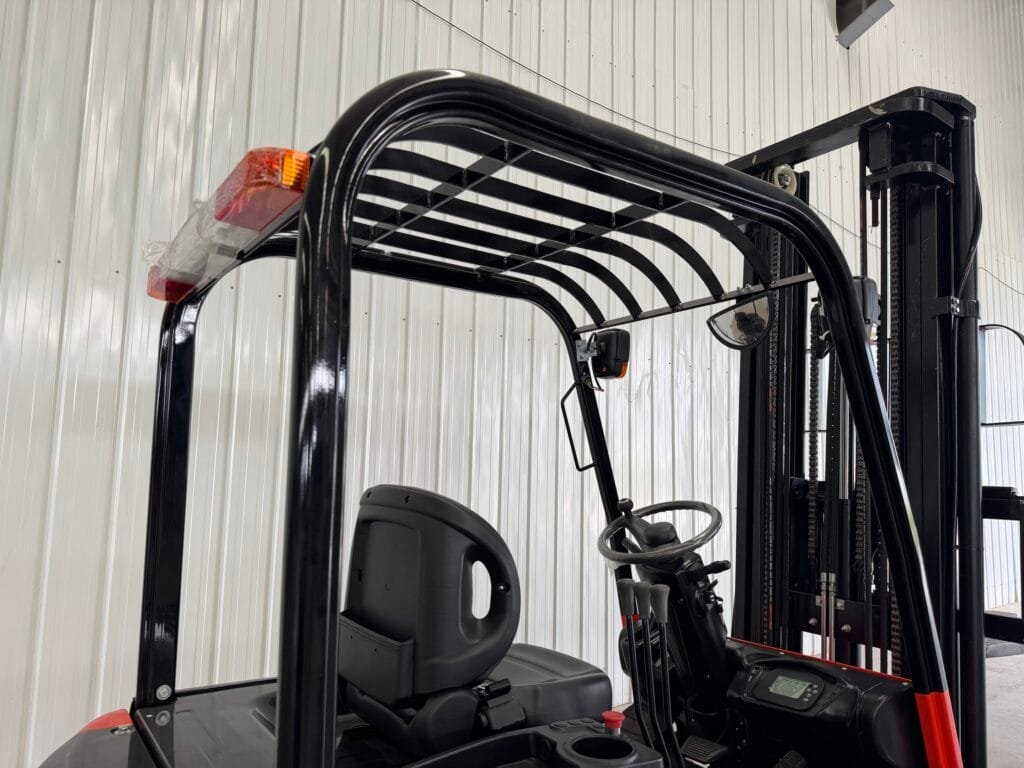
7. Challenges and the road ahead for Chinese electric forklifts
Despite the strong momentum, several challenges remain which must be addressed for the shift to be fully effective and sustainable.
7.1 Battery-raw-material supply and recycling challenges
Electric forklifts rely on batteries, and the raw‐material extraction and battery manufacturing have environmental and ethical implications (lithium, cobalt, rare earths, etc.). Recycling of batteries is still emerging in many places. Ensuring that the electric forklift supply chain is sustainable end-to-end is key for the “greener future” claim to hold.
7.2 Infrastructure, charging and standardisation issues
Switching to electric forklifts means fleets and warehouses must adopt charging infrastructure, battery-management policies, possibly battery-swap systems, and ensure downtime is minimised. In many places, standards, interoperability and logistics for charging are still developing.
7.3 Ensuring global acceptance and sustainability credentials
As Chinese electric-forklift manufacturers export globally, they must meet international quality standards, safety regulations, environmental certifications and service/after-sales support expectations. Only then will electric forklifts from China compete on the basis of both cost and green-credentials, rather than only price.
8. Practical recommendations for businesses looking to adopt electric forklifts
If your organisation is considering the switch to electric forklifts, here are some practical tips:
8.1 What to evaluate when choosing an electric forklift
- Review the battery type, energy capacity, recharge time and life-cycle cost.
- Evaluate the availability of charging or battery-swap infrastructure in your facility.
- Inspect after-sales support, spare parts availability, brand reliability.
- Check for compatibility with your warehouse layout, load requirements, duty-cycle.
8.2 How to integrate them into an existing fleet
- Conduct a fleet audit: identify which internal-combustion forklifts are prime candidates for replacement.
- Pilot a small number of electric units in one area to test real-world performance.
- Plan charging infrastructure (possibly off-peak electricity, renewables) and battery management.
- Train operators and maintenance crew on differences (for example regenerative braking, battery care).
8.3 Maintenance, training and total-cost-of-ownership considerations
- Electric forklifts often have lower ongoing maintenance but require attention to battery health and charging practices.
- Consider total-cost-of-ownership over 5–10 years, including electricity, battery replacement, downtime risk, operator training.
- Incorporate environmental metrics: reductions in emissions, improved indoor air quality, potential incentives or regulatory compliance benefits.
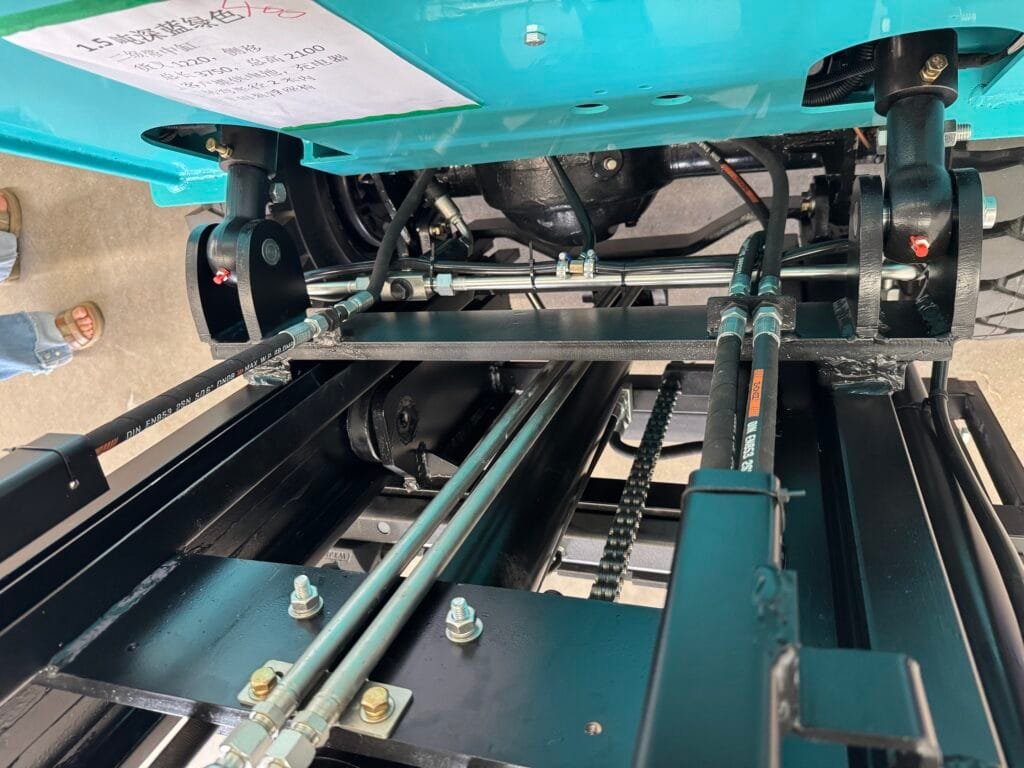
9. Future outlook: How Chinese electric forklifts will evolve and contribute further
Looking ahead, several trends are likely to shape how Chinese electric forklifts contribute to the greener future.
9.1 Expected market trends and growth projections
Industry analysis forecasts significant growth: for example, the Asia-Pacific electric forklift market, dominated by China, is projected to grow at a CAGR of around 5.2% from 2025 to 2034. As demand for e-commerce, warehousing, automation, and green logistics rises globally, Chinese electric-forklift production and export will continue to expand.
9.2 Emerging technologies (hydrogen, AI, IoT) in material-handling
Beyond batteries, technologies such as hydrogen fuel-cell forklifts, advanced telematics, autonomous material-handling robots, IoT-integrated fleets are expected to play a role. Chinese manufacturers are likely to participate actively in these advances—meaning electric forklifts today may be stepping stones to even greener and smarter solutions tomorrow.
9.3 What this means for a greener future
As more warehouses and logistic hubs adopt electric forklifts, the cumulative effect lines up with broader decarbonisation goals: lower emissions, cleaner indoor air, quieter operations, more efficient energy use, and potentially a ripple effect across supply-chains. In this way, Chinese electric forklifts aren’t just equipment—they’re part of the infrastructure that supports a greener and more sustainable future.
FAQ – Electric Forklifts & China’s Green Future
Q1: What exactly qualifies as an “electric forklift”?
A: An electric forklift is a material-handling vehicle powered by electricity—typically via rechargeable batteries such as lead-acid, lithium-ion or LFP batteries—instead of internal-combustion engines burning diesel, gasoline or LPG. Because they don’t emit exhaust gases at point of use, they are an attractive choice in indoor or emission-sensitive environments.
Q2: Why is China so important in the electric forklift market?
A: China’s large logistics, warehousing and manufacturing base creates huge domestic demand for forklifts; the country also has scaled production capacity, competitive cost structures and export orientation. Industry projections show China accounts for around 30 % of the global electric-forklift market and is growing.
Q3: What are the main environmental benefits of switching to electric forklifts?
A: The key benefits include: zero tailpipe emissions in the operational environment (better indoor air and worker health), reduced noise, improved energy efficiency, and over time a lower overall carbon footprint especially when grid power becomes cleaner. These contribute to greener logistics operations.
Q4: What challenges should companies consider when adopting electric forklifts?
A: Some of the challenges are: ensuring adequate charging infrastructure, managing battery life and replacement costs, securing reliable brands and service support, integrating change management and operator training, and assessing whether battery technology meets duty-cycle needs.
Q5: How do smaller brands like Nicosail fit into this green transition?
A: Smaller brands such as Nicosail demonstrate that electric-forklift adoption is not limited to global brand giants. With accessible cost structures and varied models, they expand the ecosystem of suppliers. Nicosail in particular offers electric forklift models alongside other machinery and is part of China’s broader manufacturing base contributing to the green shift.
Q6: Are electric forklifts always more cost-effective in the long run?
A: Many studies show electric forklifts can deliver lower total-cost-of-ownership in many settings—especially indoor operations with predictable duty cycles. Savings come from lower energy cost (electricity vs fuel), fewer moving parts, lower maintenance, and quieter operation. However, each case must evaluate battery replacement cost, duty-cycle match and infrastructure cost.
Q7: What future technologies are likely to enhance the green impact of electric forklifts?
A: Future enhancements include: hydrogen fuel-cell powered forklifts for longer duty cycles, increased battery energy density and recycling, integration with IoT and warehouse automation, smart energy management systems tied to renewable infrastructure, and improvements in telematics and predictive maintenance.
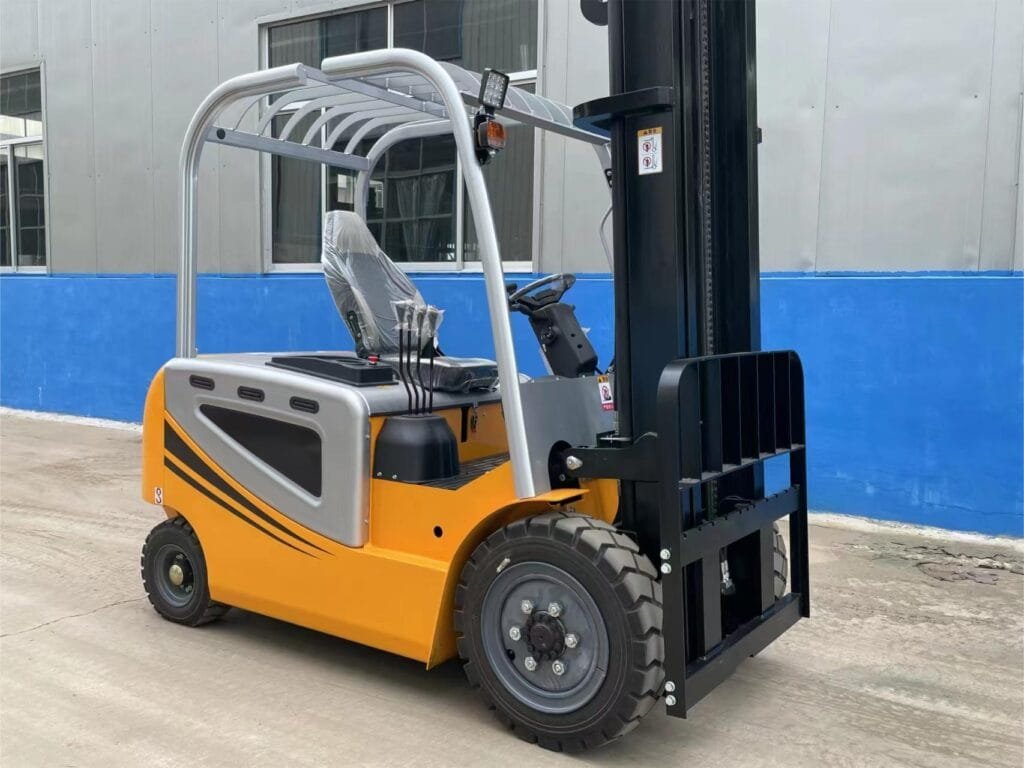
Conclusion
The shift to electric forklifts is an important—and often under-appreciated—piece of the larger sustainability puzzle in industrial logistics and supply-chains. In China, the scale of production, innovation and market growth is paving the way to a greener future. From improved battery technology to smarter fleet management, and from cost savings to reduced local emissions, the benefits are tangible. Brands like Nicosail illustrate how a diverse supplier ecosystem contributes to this transition—not just the giant names.
Of course, challenges remain: infrastructure, battery-raw-material sustainability, standardisation, global certification. But the momentum is clear. If companies and logistics networks adopt electric forklifts thoughtfully—assessing duty cycles, infrastructure, lifecycle costs—they can leverage this equipment not merely as a green token, but as a strategic asset for tomorrow’s clean-logistics world.
For businesses, logistics managers, warehouse operators and sustainability leads, the message is: electric forklifts are here, they are improving, they make environmental and economic sense—and China is at the heart of this transition.


